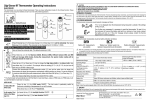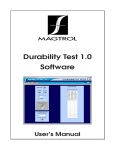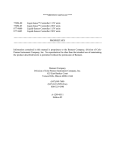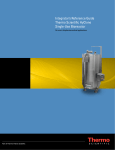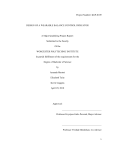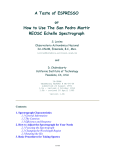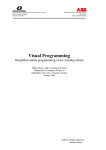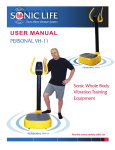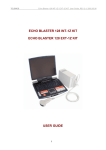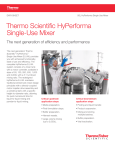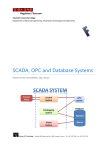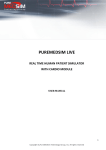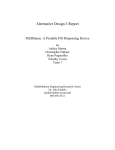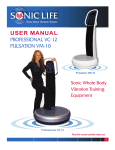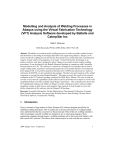Download Parts 7-12 - Biomedical Engineering
Transcript
Team 11: Page 1 ABSTRACT (1p. max) Adhesive capsulitis, or “frozen shoulder,” is a painful chronic health condition affecting 3% of people at some point in their life [1]. Inflammation of tissue in the articular capsule of the shoulder reduces the volume of synovial fluid, which results in a decreased range-of-motion and chronic and acute pain. A minimally invasive method of treatment that has seen attention recently is known as “intra-articular hydraulic distension” (IHD) among other names. This treatment specifically refers to the injection of fluid into the articular capsule to increase its volume and distend the joint, thereby relieving the painful symptoms. However, the optimal conditions for this treatment are not known, and establishing those conditions is a topic of interest in future clinical and engineering research. To this extent, the client has requested a novel device to control and monitor the injection process in real-time, as well as a device or process to position the patient and a procedure for using the device in a consistent way. Such a device will be operated through a PC, and will respond to input from the operator as well as collecting and exporting data for analysis. The device will monitor the volume injected and the intra-articular pressure in realtime, to gain a more thorough understanding of the shoulder mechanics involved. The injection rate will be feedback-controlled based on pressure and will be able to respond to characteristic traits in the pressure-volume (P-V) profile. The device should function in a diagnostic as well as a therapeutic setting, and should be reasonably portable. The user interface through the PC should be clear, effective, and comprehensive while being user-friendly and easy to use with proper training. Testing of the device on animal tissue samples is desired to test functionality and analyze tissue response. Analysis of measurement errors inherent to the device and its components is also desired. This device will address various shortcomings in the methods of recent research and provide a more consistent, accurate method of studying the procedure. The optimal design for this device required the purchase of a syringe pump, a pressure transducer, a data acquisition device (DAQ), syringes, spinal needles, tubing, and appropriate hose adaptors, as well as some additional circuit elements, wiring to connect components and the PC, a surge protector and power strip for device components, casing, a device to position the patient, and safety features. The design features a case containing the syringe pump (securely attached) and the pressure sensor, with additional circuitry and electronic components in a separate compartment for waterproofing purposes. The case will have some storage room for additional parts or components, and includes a locking system and handle for transportation purposes. Testing has been performed or planned to ensure that each component functions properly, and to analyze the measurement errors of the device. Safety of the device for the patient and operator is a great concern, so risk factors have been identified and precautions taken to ensure safety. Assembly of the prototype is currently in progress. The biggest issue from a technical standpoint is the integration of the sensor, the DAQ, and the pump through the PC, and the computations needed to control the injection. This subsystem is the subject of current design focus. The initial budget for the prototype has been set to $1000. After purchasing the pump, DAQ, pressure sensor, and other fluid components, there is a remaining budget of approximately $220. Given that casing, electronic components, a patient positioning device, and testing samples are yet to be purchased, it is possible that some additional funding might Team 11: Page 2 need to be procured. 7) BUDGET & TIMELINE 7.1) Budget 7.1.1 NE-500 OEM Syringe Pump The most expensive component of the device has been the syringe pump itself making up half of the entire budget. The New Era brand NE-500 OEM Programmable Syringe Pump was purchased for the prototype at a cost of $520, which included a DC power adaptor for a standard wall outlet to power the device, an RS-232 cable to connect the pump to a PC for control, and a user manual [2]. This pump was chosen as the most economical option for the prototype; other pumps of comparable quality cost around $1000, with high-quality medical pumps costing several thousands of dollars. This pump is intended for use with a PC, so there is no control or display panel on the device itself; this helped to significantly reduce the cost, while bringing in the problem of having little to no user interface. The NE-500 features a simple aluminum chassis that provides a great deal of flexibility for attaching the pump to a larger device, which will be very useful in attaching the pump to our casing; this should provide significant savings on components to attach the parts since there are many possible options. 7.1.2 PendoTECH Disposable Luer-Lock Pressure Sensor While pressure transducers tend to be expensive, the make and model eventually purchased was the PendoTECH Disposable Luer-Lock Pressure Sensor, ordered from ColeParmer at a cost of $27.75 before shipping [3]. The polycarbonate sensor is reusable and can be cleaned or sterilized in order to prolong its lifetime greatly, which, combined with the relatively low cost of replacement, means this part is a very solid and reliable purchase. Since at the current time no human or live-animal testing is being done, costs of cleaning or replacement will not affect the budget. (Testing on animal tissue from a butcher is a concern, but thorough cleaning with soap and water will be sufficient for those purposes.) Detailed technical specifications for the pressure sensor and other important information is available online at the PendoTECH website [4]. 7.1.3 Cole-Parmer Vinyl Tubing and Male/Female Luer-Lock Adaptors Additional components purchased from Cole-Parmer were: 50’ bulk length of vinyl tubing, inner diameter 1/16” ($12.00); male Luer-lock adaptors with 1/16” barb hose attachment ($8.75 for a pack of 25); female Luer-lock adaptors with 1/16” barb hose attachment ($8.00 for a pack of 25); and 1-way Luer check valves, female to male flow direction ($7.00 for a pack of 10) [5,6,7,8]. These components were ordered along with the PendoTECH sensor in two shipments, at a total shipping cost of $17.04. The length of tubing with the barb hose Luer adaptors allows for a great degree of flexibility in device construction, as well as offering a more economical option when compared to purchasing set lengths of hose with pre-fit Luer attachments. This will allow us or the operator to cut individual segments of hose to a desired length and easily attach the Luer-locks ensuring everything is secure and leak-proof. The oneway check valves can be used to prolong the life of the devices by allowing fluid to flow in only Team 11: Page 3 one direction, meaning that components will prevent backflow and could eliminate the need to replace every single component after each use, with maybe only a quick cleaning needed for parts upstream while only the check valve and downstream components would require replacement and sterilization (certainly during proposed testing on animal tissues in the current scope of the project). This will ultimately help control design costs by minimizing replacement or cleaning costs though care must be taken to ensure that no contamination occurs. 7.1.4 Terumo 30 mL Syringes When it came to purchasing the syringes needed for the pump, several considerations had to be kept in mind. The pump itself is designed to take syringes that hold anywhere from 1 cc up to a maximum of 60 cc, meaning that the syringe size chosen would have to be compatible with the pump. Looking at the amount of fluid used by previous IAHD procedures, it was determined that around 30 mL was the average volume of synovial fluid found in patients with Adhesive Capsulitis, meaning a 30 cc syringe would suffice for this application. Another consideration that had to be addressed was the Connecticut laws regarding the limits placed on the purchase of syringes, with state law dictating that, without a licensed medical practitioner's prescription, an individual is allowed to purchase only up to 10 syringes at a time. Luckily, this obstacle was successfully avoided by purchasing a box of ten 30 cc Terumo syringes, which came with Luer-locks for easy attachment, and have been pre-sterilized in individual wrappers, all for the low price of $7.50 from Super Medical Supply (through Amazon.com) [9]. 7.1.5 Spinal Needle A future budget concern is the purchase of a needle. Because of the depth of the articular capsule in many patients, a long needle is necessary; typically a 3.5” spinal needle is used in the literature. Unfortunately, these needles are very expensive, and can only be purchased in bulk orders of 100 or more, at a cost of over $100. Since the scope of testing is very limited in the current project, this expense is unnecessarily and prohibitively large. One option may be to continue searching for spinal needles sold individually or in small quantities, or to substitute an ordinary hypodermic needle for the time being and evaluate if those may be purchased more economically given the budgetary constraints of the current project. 7.1.6 National Instruments USB-6008 Data Acquisition System Since more than half of the budget has been spent on just the syringe pump, this meant that purchasing the other parts of the device would be much more limited. The second most expensive item ordered to date has been the National Instruments USB-6008 Data Acquisition device [10]. This make and model was chosen due to its guaranteed compatibility with LabVIEW, small size and weight, ease of operation, and low-cost impact on the budget at $152.10 with $17.63 for shipping and handling. Some of the trade offs encountered in order to keep the budget intact have been the device’s resolution of 12-bits and its maximum data acquisition rate of 10k samples/second. This device was chosen so that it can be used in a prototype, with connections quickly removed or replaced if the design changes. Future devices based on this prototype would likely have a more permanent data acquisition device to ensure a long lifetime (preferably with wires soldered on and secured); for financial reasons it was not possible to purchase such a device in addition to the DAQ which is necessary at least initially. Team 11: Page 4 7.1.7 Casing The casing options for the medical device have not been thoroughly investigated due to the current focus of the project still being aimed at the actual components that would be housed inside. Several manufacturers that specialize in the manufacture of hard plastic cases with specialized foam inserts, as previously discussed. Care would have to be taken in choosing the right size so as to accommodate all of the necessary components, while leaving extra room for additional parts/tools that the client would like to see incorporated into the final design. Safety is also an issue: the device must be stable, free of sharp corners, and preferably as lightweight as possible; electronics must be fully insulated to prevent damage or shorts due to leaks, spills, or daily wear-and-tear; 7.1.8 Patient Arm Positioning System An additional expense that must be considered is a device for positioning the patient’s body and arm and stabilizing the shoulder in a stationary position, in order to minimize measurement errors from deformation of the capsule. The best position to have the arm in is not clear and will be a subject for future research; in the meantime, the client wishes to have a way to stabilize the arm in a consistent position to collect good data on other parameters. The cost of this device depends on the desired position; previous research has only had the patient sit on a stool while resting their hand palm-down on the middle of their quadriceps [Chung et al 2009]. This position may not require a device and would involve only a set of instructions or a procedure for ensuring no motion is necessary, which would not impact the budget. If, however, it is desirable to hold the arm at a certain abduction or rotation, a device would have to be purchased or built with appropriate restraints. This may require the modification of an existing part, such as some sort of sling or shoulder support that an individual recovering from surgery might have, or it may require the design of a new device. The costs of this device are unknown at this time; further discussion with the client is needed to understand if there is a preferred position. If a device is necessary, it would also likely be designed with the rest of the device in mind--for example, with attachments to secure tubing and minimize loose wires. If no device is necessary for the positioning aspect itself, some sort of armband or attachment will most likely still be provided to secure components proximal to the shoulder (since displacement of the needle due to natural motion of the patient is not desirable). 7.1.9 Safety Precautions The safeties of not only the patient, but also the operator and the device itself, have to be addressed in a very economic fashion so as to reduce their impact on the budget while ensuring the utmost quality in harm prevention. Incorporation of an emergency “kill switch” to immediately stop the procedure if the patient feels uncomfortable will require the use of a handheld thumb button switch that is able to be connected to the PC or device, with preliminary searches showing a potential cost of around $60. An alternative approach would be to incorporate an emergency stop button in the user interface on the PC, but this would necessitate extreme awareness of the patient on the part of the operator. A power button on the device itself could serve as a failsafe, though this would be a last resort as all components would be powered down. The use of a surge protector to connect all of the individual parts of Team 11: Page 5 the device will reduce the potential for any electrical shocks that could damage the patient, user, or the sensitive components found in the parts. The proper safety ratings and regulations would have to be researched so as to provide the maximum amount of safety needed while keeping the costs low, with preliminary searches showing starting prices of surge protectors around $10, with increasing costs for higher quality devices. Electrical safety is a major concern for the operator and user, so care will have to be taken to ensure the device is properly grounded, that static charges that could potentially shock someone don’t build up, and that the fluid system is well insulated from any electronic components and vice versa. When it comes to proper patient sterilization, the option to include storage compartments for the necessary tools is available, but stocking them with bandages, gauze, etc. might fall upon the user once the initial supplies have been used up. 7.2) Timeline (minimum of 50 tasks) ● Review literature on Adhesive Capsulitis (Fall 2012) ○ Causes, Symptoms, Treatments ○ Diagnosis ○ Establish working technical understanding of the problem ● Review IAHD and past procedures in the scientific literature (Fall 2012) ○ Typical procedure ○ Solution composition ○ Measurements made ○ Data of interest (studied or unknown) ○ Other important technical concerns ● Order parts ● Work on LabVIEW ○ Create front panel ○ Connect PC to Data Acquisition Device ■ Provide voltage source to pressure transducer ■ Amplify signal from pressure transducer ■ Connect pressure transducer to DAQ ■ Read signal from DAQ in PC ○ Connect PC to syringe pump ■ Modify existing LabVIEW driver to meet needs ■ Connect via RS-232 cable ○ Establish control of syringe pump ■ Establish mechanism of adjusting injection rate in real-time ○ Integrate controls with front panel ○ Establish way of collecting & processing data from DAQ ○ Implement negative feedback control loop ○ Implement control based on characteristics of pressure-volume curve ○ Implement diagnostic functions based on P-V response ● Work on SolidWorks (for case design) ○ Model syringe pump ○ Model syringe Team 11: Page 6 ● ● ● ○ Model DAQ device ○ Model pressure transducer ○ Model tubing ○ Assemble above components in case ○ Model other parts as needed Fluid system testing ○ Leak analysis of system ■ Pressurize system with air, seal ■ Evaluate pressure drop with time as volume is held constant ■ Compare to Ideal Gas law estimations ■ Pressurize system with water ■ Observe system for any leakages ■ If leakages are found, evaluate means of sealing the system and retest ○ Accuracy analysis of pressure sensor reading ■ Seal system with air at ambient pressure ■ Change the volume at set increments ■ Read the pressure at each point ■ Compare to Ideal Gas Law predictions ■ Seal system with water ■ Hold pressure sensor at various heights relative to syringe ■ Read pressure at each point ■ Compare to Bernoulli Equation predictions ■ Assess errors ■ Compare empirically measured errors to manufacturer-provided error margins ○ Accuracy analysis of volumetric flow rate ■ Fill syringe with water ■ Set pump for a given rate for a given time ■ Collect water pumped ■ Obtain mass of water pumped ■ Convert mass to volume ■ Compare volume obtained to volume predicted by multiplying flow rate by total time ■ Assess errors for different flow rates and times ■ Establish overall picture of error ■ Compare to error estimation provided by manufacturer Noise Analysis ○ Evaluate signal from DAQ for noise ○ If noise is excessive: ■ Evaluate if high-frequency noise can be eliminated from signal without disturbing the actual response of the system ■ Implement analog filter if possible (computational filter would slow down the computer) Error analysis Team 11: Page 7 ○ ● ● ● ● ● ● Establish relationship between intra-articular pressure and pressure at the sensor ■ Use Bernoulli’s equation of steady, inviscid, incompressible flows to establish a real-time conversion ● Evaluate viscosity and change in flow over time to ensure they are negligible and that Bernoulli’s equation may be used at points in time ■ Analyze effect of flow rate error/variation on pressure reading ■ Analyze effect of elevation error/variation on pressure reading ○ Integrate analysis of these errors into front panel/data processing programs ○ Evaluate if there are any insights to improving accuracy of device Set up animal parts dissection and testing experiment ○ Design setup ○ Confirm procedure with Dr. Gielo-Perczak ○ Build setup as necessary Order Animal Parts ○ Contact butcher re: availability, costs ○ Order parts, await delivery Test animal parts ○ Tension stress testing with Tinius Olsen machine ○ Articular distension using device ○ Test response of device pressure signal due to change in arm position Animal parts test data analysis ○ Stress/strain, viscoelastic behavior ○ Maximum stress; point at which tissue damage occurs ○ Effect of position on intra-articular pressure Build case based on SolidWorks modelling ○ List all components to be included in case ○ Estimate size of case ○ Search ready-made products for cases of appropriate size and construction ■ If available cheaply, purchase a case ■ If no options available, case will have to be built from scratch ● Purchase durable plastic, fasteners, foam inserts ○ Assemble outer case and internal components in SolidWorks ○ Evaluate needs for internal construction, compartments, etc. ○ Manufacture or purchase components as needed ○ Assemble the device with casing Build patient positioning device or establish procedure to use ○ Evaluate if there is an optimal procedure, or a specific position desired by client ○ Evaluate if there is a simple method to maintain a certain stable arm position ○ If so: Develop such a method with specific details and instructions ○ If not: Develop a device to hold the arm in a stable position 8) TEAM MEMBER CONTRIBUTIONS (1p. min) 8.1) Vesko Zlatev Team 11: Page 8 While early work has not required a significant amount of biomaterials work (which is Vesko’s track), he has so far specialized in the electronics and programming parts of the project. The greatest technical issues this project faces involves attaching the pressure transducer to the DAQ, connecting the DAQ and syringe pump to the PC, collecting data from the DAQ, and controlling the pump. Vesko was able to find a LabVIEW-based driver and control panel emulator for the syringe pump on the National Instruments website, and has begun the process of modifying it to suit the needs of the project [11]. He has successfully used this driver to connect and communicate with the pump, and was able to control basic pump programs. He has also begun the process of connecting the pressure transducer to the DAQ device and analyzing the signals collected through LabVIEW, with issues therein identified. He has also reviewed the information provided by the manufacturers of the pump, DAQ, and pressure sensor to better understand the error inherent to each component to determine what steps must be taken to get good accurate signals. He has also established contact with a butcher that could provide animal tissue samples for device testing in the spring semester, and when such testing is done his experience in materials science will prove invaluable in analyzing the response of the tissue to various applied stresses. 8.2) Kyle Bagshaw As a biomedical engineering major in the biofluid biomechanics track, Kyle has specialized so far in analyzing the fluid components of the system, with an emphasis on understanding errors. He devised several tests to check the components of the fluid system for leaks and error, including the accuracy of the pressure sensor and the flow rate accuracy of the pump. He has also created a simplified model of flow in the hose using Bernoulli’s equation, that can be used to estimate errors due to the fluid flow and to correct pressure readings in realtime. He has also created a preliminary algorithm for adjusting pump flow rate based on change in pressure over time, which can be implemented into the LabVIEW pump driver by Vesko as the system begins to come together. Kyle has also taken responsibility for tracking the budget and submitting purchase requests as it seemed best to consolidate those tasks, though both members were important in identifying components to purchase. 8.3) Combined Contributions Some tasks have been shared by both members. These include the review of scientific and health literature on frozen shoulder and hydraulic distension; an extensive collection of relevant reference sources on the topics was gathered and reviewed for relevance, with a few particularly pertinent sources identified. Both members have been involved in constructing CAD models of device components in SolidWorks, so that in the spring semester they can be combined in an assembly and used to design a case precisely fitted to needs. The scope of the project is fairly broad and requires design of a new device combining many features not previously combined or even used in a device or invention before, so both members were extensively involved in brainstorming to determine possible designs, the optimal design, safety concerns, constraints, necessary subsystems and subunits, how all parts would be integrated, what errors might exist and how they might be analyzed, and how the device might be tested. 9) CONCLUSION (1p. min) Team 11: Page 9 All in all, a great amount of progress has been made towards the designing and engineering of a device that will be able to perform the novel intra-articular hydraulic distension procedure on patients suffering from Adhesive Capsulitis. The device itself will incorporate and improve upon several key features that were found to be common between past distention procedures, as well as incorporating several novel features. These include the ability to monitor the intra-articular pressures found within the joint in real-time during the operation, the option to quickly export/import patient data gathered so as to share with the medical community, the implementation of a proper shoulder restraint system so as to minimize the shifts in capsule volume during slight movements, and to establish some form of a standard when it comes to successfully performing this procedure that could ultimately provide an alternative treatment option for sufferers of Stiff Shoulder Syndrome. The implementation of a negative feedback control of the injection rate based on pressure in the articular capsule as proposed by the client is entirely new. The entire device will also be controlled through a single panel in LabVIEW, which will incorporate user inputs, controls, and data displays to comprehensively monitor the procedure in real-time. Some other notable functionalities that could further ensure an overall beneficial , and not detrimental, therapeutic outcome include the integration of safety mechanisms for not only the patient, but also the operator and the device itself; performance of in-depth error analysis for each of the components and establishment of ways to minimize them; diagnostic capabilities to determine if an individual has frozen shoulder or some other condition that wouldn’t be treated by distension; and a comprehensive protocol for safe use of the device including all parts of the procedure from setup and patient preparation, to performing the procedure, to processing data and analyzing the results. After analysis of the specifications and discussion of possible alternative designs, it was decided to build a device using pre-manufactured components where possible. A syringe pump, pressure transducer, and DAQ device were purchased as the major items, as were necessary tubing and adaptors. Construction of the device has begun with efforts to attach the major components to the PC, in order to first obtain accurate and reliable measurements from the pressure sensor and control of the syringe pump. Difficulties have been encountered during this process, so this has proven to be the major technical obstacle to completion of the project. Current work has involved connecting electronic components, programming LabVIEW to have a functional front panel and processing tools, and modelling device components in SolidWorks to design a case in the future. Future work includes testing the device to ensure it functions properly with no leaks, testing the device to analyze errors in measurement or control that could impact results, building an appropriate case for the device and packaging it effectively, designing a system or device to secure the position of the patient, and additional testing and modifications for safety concerns. Finally, the device will be tested with animal tissues purchased from a butcher to ensure it works properly, and final adjustments will be made before it is delivered to the client. The major constraints on this project are safety and budget issues. Due to the limited budget available, top-quality components were not affordable, so less expensive off-the-shelf components had to be purchased. While these components will be sufficient for a prototype, future devices made for clinical use or even large-scale production would likely have to address this. Safety is another major concern, for both the patient and operator. Biological hazard management is important, so the device has to be designed so that potentially contaminated Team 11: Page 10 components can be easily removed and sanitized or replaced. This affects the budget, as the cost of replacement parts or cleaning must be considered; by choosing bulk tubing and a disposable pressure sensor the design minimizes these costs. Electrical safety is also important, so insulating electronic components well will be important particularly when designing the case. Other precautions will be identified and taken when considering the patient positioning system to ensure that the patient is not at risk of electrical shock. When completed, this project will have produced a device that fulfills a need for a better method of studying hydraulic distension. Through the integration of many parts of the procedure into a single device, and the implementation of novel features such as feedback control of the pump, analysis and estimation of measurement errors, a device to position the patient, casing that allows the device to be portable or easily transported, and an unprecedented degree of control over the pump program, this device could pave the way to a much more rigorous understanding of hydraulic distension, frozen shoulder, and shoulder biomechanics. 10) REFERENCES (1p. min) Section 1 [1] Manske, Robert and Daniel Prohaska, “Diagnosis and management of adhesive capsulitis,” Curr Rev Musculoskelet Med, December 2008. Available: http://www.ncbi.nlm.nih.gov/ pmc/articles/PMC2682415/ [2] “Frozen Shoulder,” MedlinePlus, www.nlm.nih.gov/medlineplus, 2012. Available: http:// www.nlm.nih.gov/medlineplus/ency/article/000455.htm [3] “Frozen Shoulder - Causes,” NHS Choices, www.nhs.uk, 2012. Available: http://www.nhs.uk/ Conditions/Frozen-shoulder/Pages/Causes.aspx Section 2 [1] Chung, et al., “Intra-articular Pressure Profiles of Painful Stiff Shoulders Compared With Those of Other Conditions”, American Academy of Physical Medicine and Rehabilitation [online], Volume 1 (Issue 4), p.297-307, (2009, April) Available: http:// www.ncbi.nlm.nih.gov/pubmed/19627912 [2] Inokuchi, et al., “The relation between the position of the glenohumeral joint and the intra-articular pressure: An experimental study”, Journal of Shoulder and Elbow Surgery [online], Volume 6 (Issue 2), p.144-149, (1997, April) Available: http:// www.sciencedirect.com/science/article/pii/S1058274697900355 [3] Kim, et al., “Capsule Preservation Improves Short-Term Outcome of Hydraulic Distension in Painful Stiff Shoulder”, Journal of Orthopedic Research [online], Volume 29 (Issue 11), p.1688-1694, (2011, November) Available: http://www.ncbi.nlm.nih.gov/pubmed/ 21520264 [4] Lee, et al., “Real-Time Pressure Monitoring of Intraarticular Hydraulic Distension for Painful Stiff Shoulders”, Journal of Orthopaedic Research [online], Volume 26 (Issue 7), p. 965970, (2008, August) Available: http://www.ncbi.nlm.nih.gov/pubmed/18271012 Sections 3-10 Team 11: Page 11 [1] “Frozen Shoulder (adhesive capsulitis),” Virtual Medical Centre, 2009. Available: http://www.virtualmedicalcentre.com/diseases/frozen-shoulder-adhesive-capsulitis/497 [2] NE-500 Programmable OEM Syringe Pump, New Era Pump Systems Inc. 2012. Available: http://www.syringepump.com/oem.php [3] PendoTECH Single-Use Sensor, Luer Fitting, Cole-Parmer Inc. 2012. Available: http://www.coleparmer.com/Product/ PendoTECH_PressureMAT_Single_Use_Sensor_Luer_Fitting_Polycarbonate/EW19406-32 [4] Single Use Pressure Sensors, PendoTECH 2010. Available: http://www.pendotech.com/ products/disposable_pressure_sensors/disposable_pressure_sensors.htm [5] Vinyl tubing, Cole-Parmer Inc. 2012. Available: http://www.coleparmer.com/Product/ Vinyl_Tubing_1_16_ID_x_1_8_OD_50_ft_pack/EW-06405-01 [6] Male luer with lock ring x 1/16” hose barb, Cole-Parmer Inc. 2012. Available: http://www.coleparmer.com/Product/ Male_luer_with_lock_ring_x_1_16_hose_barb_PP_25_pk/EW-45503-00 [7] Female luer x 1/16” hose barb, Cole-Parmer Inc. 2012. Available: http:// www.coleparmer.com/Product/Female_luer_x_1_16_hose_barb_adapter_PP_25_pk/ EW-45500-00 [8] One way Luer check valves, Cole-Parmer Inc. 2012. Available: http:/ /www.coleparmer.com/Product/ One_way_luer_check_valve_SAN_with_silicone_diaphragm_female_male_pack_of_10/ EW-30505-92 [9] Terumo Syringe 30cc Luer Lock Tip Sterile, Terumo 2012. Available: http:// www.amazon.com/Terumo-Syringe-30cc-Luer-Sterile/dp/B008NVUTIQ/ref=sr_1_8? s=hpc&ie=UTF8&qid=1354123681&sr=1-8 [10] NI USB-6008, National Instruments Inc. 2012. Available: http://www.ni.com/products/usb6008/ [11] New Era Pump Systems NE-500 Driver, National Instruments Inc. 2012. Available: http:// sine.ni.com/apps/utf8/niid_web_display.model_page?p_model_id=8502 11) ACKNOWLEDGEMENTS We would like to thank first and foremost our client and faculty advisor, Dr. Krystyna Gielo-Perczak, along with our TA, Ms. Sarah Brittain, for their guidance throughout this process. We would also like to thank Dr. John Enderle for his support of the Senior Design course and lecture materials. We would like to acknowledge Mr. David Kaputa for his information regarding butchers to contact for animal tissue samples. Finally, our thanks to Mr. Orlando Echevarria for his assistance with our course website. 12) APPENDIX 12.1) Updated specifications Team 11: Page 12 There have not been many significant changes to the project specifications throughout the design process, the client’s needs were expressed quite clearly. Given the choice of DAQ device, it seems that some sort of amplification of the pressure sensor signal is necessary before it is sent to the DAQ, as there have been issues due to quantization for the current settings. Signal amplification is necessary to get the smoothest curve possible, which is necessary because the sensor has to be very sensitive to changes in pressure. Additionally, the concern of using an imaging device such as an ultrasonograph has been eliminated from the project in its current scope due to the lack of availability of such a device for the time being and the prohibitive cost of purchasing one. Such a device is necessary for reliable testing as it verifies the insertion of the needle into the articular capsule, but since the device is not available it is an issue of future concern. It was initially desired to encapsulate as many components as possible into a single case; however this seems infeasible for the prototype being designed here due to budgetary constraints and the inability to purchase the ideal parts that would be needed. 12.2) Purchase requisitions & price quotes (attached) Team 11: Page 13 12.3) Additional Information













